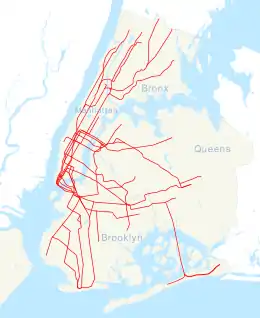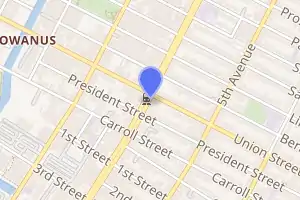Union Street station (BMT Fourth Avenue Line)
Union Street is a local station on the BMT Fourth Avenue Line of the New York City Subway. It is located at the corner of Fourth Avenue and Union Street in Brooklyn, New York City, serving the communities of Park Slope, Gowanus and Carroll Gardens. It is served by the R train at all times. The D and N trains also stop here during late nights, and some rush-hour W trains stop here in the peak direction.
Union Street | ||||||||||||||||||||||||||||||||||||||||||||||||||||||||||||||||||||
|---|---|---|---|---|---|---|---|---|---|---|---|---|---|---|---|---|---|---|---|---|---|---|---|---|---|---|---|---|---|---|---|---|---|---|---|---|---|---|---|---|---|---|---|---|---|---|---|---|---|---|---|---|---|---|---|---|---|---|---|---|---|---|---|---|---|---|---|---|
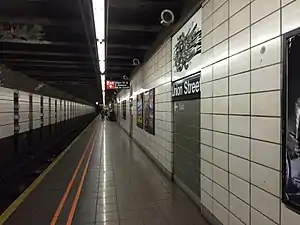 Manhattan bound platform | ||||||||||||||||||||||||||||||||||||||||||||||||||||||||||||||||||||
| Station statistics | ||||||||||||||||||||||||||||||||||||||||||||||||||||||||||||||||||||
| Address | Union Street & Fourth Avenue Brooklyn, NY 11217[1] | |||||||||||||||||||||||||||||||||||||||||||||||||||||||||||||||||||
| Borough | Brooklyn | |||||||||||||||||||||||||||||||||||||||||||||||||||||||||||||||||||
| Locale | Park Slope | |||||||||||||||||||||||||||||||||||||||||||||||||||||||||||||||||||
| Coordinates | 40°40′38″N 73°58′59″W | |||||||||||||||||||||||||||||||||||||||||||||||||||||||||||||||||||
| Division | B (BMT) | |||||||||||||||||||||||||||||||||||||||||||||||||||||||||||||||||||
| Line | BMT Fourth Avenue Line | |||||||||||||||||||||||||||||||||||||||||||||||||||||||||||||||||||
| Services | D N R W | |||||||||||||||||||||||||||||||||||||||||||||||||||||||||||||||||||
| Transit | ||||||||||||||||||||||||||||||||||||||||||||||||||||||||||||||||||||
| Structure | Underground | |||||||||||||||||||||||||||||||||||||||||||||||||||||||||||||||||||
| Platforms | 2 side platforms | |||||||||||||||||||||||||||||||||||||||||||||||||||||||||||||||||||
| Tracks | 4 | |||||||||||||||||||||||||||||||||||||||||||||||||||||||||||||||||||
| Other information | ||||||||||||||||||||||||||||||||||||||||||||||||||||||||||||||||||||
| Opened | June 22, 1915[3] | |||||||||||||||||||||||||||||||||||||||||||||||||||||||||||||||||||
| Station code | 028[4] | |||||||||||||||||||||||||||||||||||||||||||||||||||||||||||||||||||
| Accessible | not ADA-accessible; accessibility planned | |||||||||||||||||||||||||||||||||||||||||||||||||||||||||||||||||||
| Opposite- direction transfer | No | |||||||||||||||||||||||||||||||||||||||||||||||||||||||||||||||||||
| Traffic | ||||||||||||||||||||||||||||||||||||||||||||||||||||||||||||||||||||
| 2019 | 2,271,983[5] | |||||||||||||||||||||||||||||||||||||||||||||||||||||||||||||||||||
| Rank | 207 out of 424[5] | |||||||||||||||||||||||||||||||||||||||||||||||||||||||||||||||||||
| Station succession | ||||||||||||||||||||||||||||||||||||||||||||||||||||||||||||||||||||
| Next north | Atlantic Avenue–Barclays Center: D | |||||||||||||||||||||||||||||||||||||||||||||||||||||||||||||||||||
| Next south | Ninth Street: D | |||||||||||||||||||||||||||||||||||||||||||||||||||||||||||||||||||
| ||||||||||||||||||||||||||||||||||||||||||||||||||||||||||||||||||||
| ||||||||||||||||||||||||||||||||||||||||||||||||||||||||||||||||||||
| ||||||||||||||||||||||||||||||||||||||||||||||||||||||||||||||||||||
| ||||||||||||||||||||||||||||||||||||||||||||||||||||||||||||||||||||
The Union Street station was constructed as part of the Fourth Avenue Line, which was approved in 1905. Construction on the segment of the line that includes Union Street started on December 20, 1909, and was completed in September 1912. The station opened on June 22, 1915, as part of the initial portion of the BMT Fourth Avenue Line to 59th Street. The station's platforms were lengthened in 1926–1927,[6] and again during a renovation in 1968–1970.[7] The station was also renovated in 1970 and in the mid-1990s.
History
Construction and opening
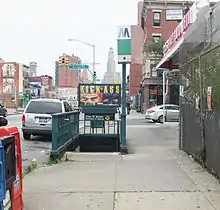
The Union Street station was constructed as part of the Fourth Avenue Line, the plan for which was initially adopted on June 1, 1905.[8] The Rapid Transit Commission was succeeded on July 1, 1907, by the New York State Public Service Commission (PSC), which approved the plan for the line in late 1907.[9][10] The contract for the section of the line that included the Union Street station, Route 11A2, which extended from 10th Street to Sackett Street, was awarded on May 22, 1908, to the E.E. Smith Construction Company for $2,296,234.93 (equivalent to $65,341,000 in 2019). The New York City Board of Estimate approved the contract on October 29, 1909.[9][11] Construction on the segment started on December 20, 1909, and was completed in September 1912.[8]
As part of negotiations between New York City, the Brooklyn Rapid Transit Company (BRT), and the Interborough Rapid Transit Company for the expansion of the city's transit network, the line was leased to a subsidiary of the BRT. The agreement, known as Contract 4 of the Dual Contracts, was signed on March 19, 1913.[9] Union Street opened on June 22, 1915, as part of an extension of the subway to Coney Island, which included the Fourth Avenue Line north of 59th Street as well as the entire Sea Beach Line.[12][3] The station's opening was marked with a competition between two trains heading from Chambers Street station in Manhattan to the Coney Island station, one heading via the West End Line and the other via the Sea Beach Line; the latter got to Coney Island first.[3]
1920s
On June 27, 1922, the New York State Transit Commission directed its engineers to prepare plans to lengthen the platforms at 23 stations on the lines of the Brooklyn–Manhattan Transit Corporation (BMT), the successor to the BRT, to accommodate eight-car trains. As part of the project, Union Street's platforms would have been lengthened from 435 feet (133 m) to 530 feet (160 m).[13][14] Though the Transit Commission ordered the BMT to lengthen these platforms in September 1923, progress on the extensions did not occur until February 16, 1925, when the New York City Board of Transportation (NYCBOT) directed its engineers to prepare plans to lengthen the platforms at this and eleven other stations along the Fourth Avenue Line. It estimated the project's cost to be $633,000 (equivalent to $9,228,000 in 2019).[15] The NYCBOT received bids for the project on February 25, 1926.[16] The contract was awarded to the Corson Construction Company for $345,021 (equivalent to $4,983,000 in 2019).[17] The extensions opened on August 1, 1927.[6]
1950s and 1960s
In July 1959, the New York City Transit Authority (NYCTA) announced that it would install fluorescent lighting at the Union Street station and five other stations along the Fourth Avenue Line for between $175,000 and $200,000. Bids on the project were to be advertised on August 7, 1959 and completed by fall 1960.[18]
In the 1960s, the NYCTA started a project to lengthen station platforms on its lines in Southern Brooklyn to 615 feet (187 m) to accommodate 10-car trains.[7] On July 14, 1967, the NYCTA awarded a contract to conduct test borings at eleven stations on the Fourth Avenue Line, including Union Street, to the W. M. Walsh Corporation for $6,585 (equivalent to $50,492 in 2019) in preparation of the construction of platform extensions.[19] The NYCTA issued an invitation for bids on the project to extend the platforms at stations along the Fourth Avenue Line between Pacific Street and 36th Street, including those at Union Street, on March 28, 1969.[20] The contract was awarded to the Horn Construction Company on May 13, 1969, for $7,381,890 (equivalent to $51,466,000 in 2019). Funding for the renovation projects came out of the NYCTA's 1969–1970 Capital Budget, costing $8,177,890 (equivalent to $57,015,000 in 2019) in total.[21]
As part of the renovation project, the station's platforms were extended 85 feet (26 m)[7] to the north,[22] and the station's elaborate mosaic tile walls were covered over with 8-by-16-inch (20 by 41 cm) white cinderblock tiles. The latter change, which was also made to 15 other stations on the BMT Broadway and Fourth Avenue Line, was criticized for being dehumanizing. The NYCTA spokesman stated that the old tiles were in poor condition and that the change was made to improve the appearance of stations and provide uniformity. Furthermore, it did not consider the old mosaics to have "any great artistic merit".[23]
1990s
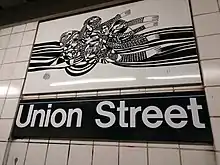
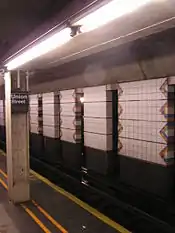
The station was renovated again from 1991 to 1994. The $2.397 million (equivalent to $4,499,000 in 2019) contract for the project was awarded on February 28, 1991. During the closure of the Bay Ridge-bound platform, the glazed tiles at the station were heavily defaced with graffiti, and were cleaned prior to the station's reopening with a heavy duty cleaner, which damaged the glazing. A modification to the contract was approved on May 23, 1994. As part of the modification, new graffiti resistant ceramic tile was installed, signage, advertising panels, benches and trash bins were removed and reinstalled, exhaust systems were added in the porter rooms at both platforms, and the wall-mounted conductors board was replaced by a ceiling-mounted one. The modification cost $174,000 (equivalent to $300,000 in 2019), and change orders cost $111,004 (equivalent to $191,000 in 2019).[24]:C-99, C-100 The Brooklyn-bound platform was closed between July 15 and November 15, 1991,[25] while the Manhattan-bound platform was closed between February 19 and June 20, 1992.[26][27]
In addition to upgrading the same elements that were replaced in the previous overhaul, floors and track wall tiling, the public announcement system, and safety treads along platform edges and track-beds were replaced. It also included an art installation by Emmett Wigglesworth called CommUnion. It features twenty-two panels of various designs in the recessed area of the platform tiles above the station signs and other designs on the openings in the track walls.[28][29]
Proposed accessibility
As part of the 2015–2019 Metropolitan Transportation Authority Capital Program, $300 million was allocated to enhance station access and provide ADA-accessibility at 15 stations chosen by New York City. Four stations were being evaluated for such improvements, including the Union Street station.[30][31]
Station layout
| G | Street level | Exit/entrance |
| P Platform level |
Side platform | |
| Northbound local | ← ← ← ← | |
| Northbound express | ← | |
| Southbound express | | |
| Southbound local | | |
| Side platform | ||
This underground station has four tracks and two side platforms.[32] The R stops here at all times;[33] some rush-hour W trains stop here in the peak direction;[34] and the D and N stop here during late nights, but use the center express tracks to bypass the station during daytime hours.[35][36] A white tiled curtain wall separates the express tracks from the local tracks.[37]
Both platforms are columnless except for a section at their extreme north ends,[22] where they were extended in 1970 to accommodate 10-car trains. Here, the columns are cream colored I-beams. The ceiling is lower in this section.[38][39]
Prior to the station's 1970 renovation, it was finished all in white and marble tile, and it had its own color scheme to allow regular passengers to identify the station based only on the color of the marble trimmings.[9] Since the renovation, the station walls have consisted of white cinderblock tiles, except for small recesses in the walls, which contain gray-painted cinderblock tiles. The gray cinderblock field contains the station-name signs and white text pointing to the exits.[40]
Exits
Each platform has one same-level fare control area in the center and there are no crossovers or crossunders to allow free transfer between directions.[41] The Manhattan-bound side has a fare control area, a turnstile bank, token booth, and two street stairs. The stairs on the Manhattan-bound platform go up to the southeast corner of Union Street and Fourth Avenue while those on the Bay Ridge-bound platform goes up to the southwest corner. The Bay Ridge-bound side has a fare control area, a turnstile bank without a token booth, and two street stairs.[42][43]
References
- "Borough of Brooklyn, New York City". Government of New York City. Retrieved April 16, 2020.
- "Brooklyn Bus Map" (PDF). Metropolitan Transportation Authority. October 2020. Retrieved December 1, 2020.
- "Through Tube to Coney, 48 Minutes: First Train on Fourth Avenue Route Beats West End Line Eleven Minutes". Brooklyn Daily Eagle. June 22, 1915. Retrieved June 29, 2015 – via newspapers.com
 .
. - "Station Developers' Information". Metropolitan Transportation Authority. Retrieved June 13, 2017.
- "Facts and Figures: Annual Subway Ridership 2014–2019". Metropolitan Transportation Authority. 2020. Retrieved May 26, 2020.
- "B.M.T. Stations Ready For Eight-Car Trains". Brooklyn Standard Union. August 1, 1927. p. 1. Retrieved April 9, 2020 – via newspapers.com
 .
. - New York City Transit Authority Annual Report For The Year June 30, 1960. New York City Transit Authority. 1960. pp. 16–17.
- Rogoff, David (May 1961). "The Fourth Ave. Subway". New York Division Bulletin. Electric Railroaders' Association: 2–10. Retrieved May 8, 2017.
- Fourth Avenue Subway, Brooklyn's New Transportation Line: A Part of the Dual System of Rapid Transit of the City of New York. New York City: Public Service Commission. June 19, 1915. p. 18. hdl:2027/uiug.30112067596715 – via HathiTrust.
- "Fourth Avenue Subway Is Sent To A Committee". The Brooklyn Daily Eagle. March 20, 1908. pp. 1–2. Retrieved May 4, 2017 – via newspapers.com
 .
. - "Fourth Avenue Subway To Be Political Issue". The Brooklyn Daily Eagle. December 11, 1908. p. 1. Retrieved May 4, 2017.
- Cudahy, Brian J. (2009). How We Got to Coney Island: The Development of Mass Transportation in Brooklyn and Kings County. Fordham University Press. pp. 217–218. ISBN 978-0-8232-2211-7. Retrieved April 24, 2020.
- Legislature, New York (State) (1923). Second Annual Report of the Transit Commission (For the Calendar Year 1922). New York State Transit Commission. p. 100.
- Proceedings of the Transit Commission, State of New York Volume III From January 1 to December 31, 1923. New York State Transit Commission. 1923. p. 1277.
- "12 B-M. T. Stations To Be Lengthened; Transportation Board Orders Engineers to Prepare Contracts for Brooklyn Work. Cost Put At $633,000 Letter to Commission Urges That Company Be Compelled to Buy New Cars". The New York Times. February 17, 1925. ISSN 0362-4331. Retrieved May 4, 2017.
- "Board Receives Platform Bids For B.M.T. Lines. Six Companies Submit Prices for Extending Subway Stations". The Brooklyn Citizen. February 26, 1926. p. 5. Retrieved April 7, 2020 – via newspapers.com
 .
. - "Brooklyn Wins Big Improvement Fund". Brooklyn Standard Union. March 18, 1926. p. 20. Retrieved April 7, 2020 – via newspapers.com
 .
. - "Our Subway Stations To Be Brighter". Bay Ridge Home Reporter. July 10, 1959. p. 2. Retrieved April 7, 2020 – via newspapers.com
 .
. - Minutes and Proceedings. New York City Transit Authority. 1967. pp. 379–380.
- Engineering News-record. McGraw-Hill. 1969. p. 63.
- Proceedings of the New York City Transit Authority Relating to Matters Other Than Operation. New York City Transit Authority. 1969. pp. 280, 435, 487.
- Cox, Jeremiah (December 22, 2008). "Looking down the simple Manhattan-bound platform at Union Street". subwaynut.com. Retrieved April 7, 2020.
- Burks, Edward C. (February 21, 1970). "Subways' Colored Tile Gets Cover‐Up Job". The New York Times. ISSN 0362-4331. Retrieved April 7, 2020.
- NYC Transit Committee Agenda May 1994. New York City Transit. May 16, 1994.
- "Attention Brooklyn-Bound N R Subway Riders: Union Street Station Is Closing July 15th to November 15th". New York Daily News. July 12, 1991. Retrieved March 8, 2019 – via newspapers.com
 .
. - "Attention N, R Customers: Beginning June 20, 1992: Union Street Station Manhattan-bound platform reopens". New York Daily News. June 19, 1992. Retrieved March 8, 2019 – via newspapers.com
 .
. - "Attention N & R Subway Customers: Union St Manhattan-bound platform is closing February 19th to June 19th". New York Daily News. February 18, 1992. Retrieved March 8, 2019 – via newspapers.com
 .
. - Whitehorne, Wayne (January 15, 2000). "Showing Image 1167". www.nycsubway.org. Retrieved December 18, 2018.
- "Arts for Transit: CommUnion". MTA Arts for Transit. Metropolitan Transportation Authority. Retrieved June 2, 2007.
- MTA Board - NYCT/Bus Committee Meeting - 02/20/2018. Metropolitan Transportation Authority. February 20, 2018. Retrieved March 4, 2018 – via YouTube.
- "T7160521 Station Capacity Enhancements at Union Street on the 4 Avenue Line - Design Only". mta.info. Retrieved April 3, 2020.
- Dougherty, Peter (2020). Tracks of the New York City Subway 2020 (16th ed.). Dougherty. OCLC 1056711733.
- "R Subway Timetable, Effective November 8, 2020" (PDF). Metropolitan Transportation Authority. Retrieved December 9, 2020.
- "W Subway Timetable, Effective November 8, 2020" (PDF). Metropolitan Transportation Authority. Retrieved December 9, 2020.
- "D Subway Timetable, Effective November 8, 2020" (PDF). Metropolitan Transportation Authority. Retrieved December 9, 2020.
- "N Subway Timetable, Effective November 8, 2020" (PDF). Metropolitan Transportation Authority. Retrieved December 9, 2020.
- Cox, Jeremiah (December 22, 2008). "Looking down the simple Manhattan-bound platform at Union Street". subwaynut.com. Retrieved December 18, 2018.
- Cox, Jeremiah (December 22, 2008). "The ceiling gets extremely low right at the northern end of the station at Union Street". subwaynut.com. Retrieved December 18, 2018.
- Cox, Jeremiah (December 22, 2008). "Another view down the simple Manhattan-bound side platform at Union Street". subwaynut.com. Retrieved April 19, 2020.
- Cox, Jeremiah (December 22, 2008). "A close up of a Union Street station sign on the platform wall, with the 1960s arrow pointing for the exit beneath it". subwaynut.com. Retrieved December 18, 2018.
- Tobar, Roberto C. (May 20, 2011). "Bay Ridge-bound fare control". www.nycsubway.org. Retrieved December 18, 2018.
- Cox, Jeremiah (May 9, 2013). "Going down to the now unstaffed Bay Ridge-bound fare control area". subwaynut.com. Retrieved December 18, 2018.
- "MTA Neighborhood Maps: Park Slope" (PDF). mta.info. Metropolitan Transportation Authority. 2015. Retrieved August 2, 2015.
External links
| Wikimedia Commons has media related to Union Street (BMT Fourth Avenue Line). |
- nycsubway.org – BMT 4th Avenue: Union Street
- The Subway Nut — Union Street Pictures
- MTA's Arts For Transit — Union Street (BMT Fourth Avenue Line)
- Union Street entrance from Google Maps Street View
- Platform from Google Maps Street View
